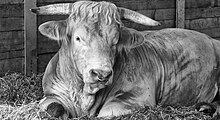Glan cattle
The Glan cattle is a traditional breed of domestic cattle that is mainly native to Rhineland-Palatinate. At the beginning of the 1980s it was almost extinct, mainly due to the changed requirements, today there are almost 2000 animals again. Breeders cite a variety of housing and usage options as the main advantages of the breed, although more emphasis is now placed on meat performance.
The Society for the Conservation of Old and Endangered Pet Breeds (GEH) has classified the breed in Category II (highly endangered) of the Red List (as of 2019).
Glan cattle have a height at the withers of 140 - 145 cm (bulls) or 135 - 140 cm (cows) and a weight of 1000 - 1200 kg (bulls) or 600 - 750 kg (cows). An important breeding goal is also the monochrome yellowish coat.
history
Today's breed of Glanviehs founded Duke Christian IV. Of Pfalz-Zweibrücken with Kör Ordinance of 12 September 1773 aimed at improving local red small country cattle by cover bulls of the Simmental and Bernerhöhe cattle demanded. The importation of Swiss cattle had already begun in 1762, so that the start of Glan cattle breeding can begin here.
At Donnersberg and Glan , two different cattle fellings developed; In addition to the light, milk-rich Glan cattle, there is also a heavy working cattle, the Donnersberger . In the 19th century, the mixture of the two (called "blood exchange") resulted in the Glan-Donnersberger , which was exported to the Hunsrück , the Westerwald and the Eifel .
The first breeding associations were founded towards the end of the 19th century (from around 1880), the first for the Glan cattle in 1895 in Meisenheim am Glan and the first for the Glan-Donnersberger cattle in 1878 in Quirnbach / Pfalz, which was also the first local breeding organization for was the Glan-Donnersberger breed at all. In addition, many small breeding associations emerged for both hideaways, which only came together at the turn of the 20th century from two large organizations. In 1898, for example, the breeding association of the same name was founded for Glan-Donnersberger cattle, based in Kaiserslautern, while the local breeding cooperatives for Glan cattle were not merged to form the Association of Rhenish Glanviehzuchtgenossenschaften with headquarters in Trier until 1912. In the beginning of the Third Reich , this rather weak association was strengthened by streamlining its organization, and in 1934 it was renamed the Association of Rheinischer Glanviehzüchter . (Note: An association with this name or a similar designation no longer exists today.)
In the 1920s, plans from 1912 began to be implemented and the yellow Franconian cattle began to refresh their blood. This breeding measure is not to be equated with crossbreeding. A decade later, breeding for milk yield became a priority in the breeding goal. The work performance, formerly one of the advantages of the breed, became less and less important and now ranked third behind the meat performance. In order to improve the milk yield, the Danish red dairy cattle were crossed from around 1950 , which led to the loss of either good milk or good meat yield . Since the active breeding population was simply too small to genetically anchor the existing facilities for both an appealing milk and excellent meat performance, the breed began to decline. The Palatinate Association preferred to increase the milk yield in the breeding goal, which from 1970 onwards resulted in the displacement crossing of the old Glan-Donnersberger with the angler cattle. To the north of this, the Trier Association sought salvation in crossing with the yellow francs, which although increased meat production, meant a sharp decrease in milk yield. In 1967 pure breeding was discontinued. In 1972 the Association of Rhenish Glan cattle breeders dissolved.
In 1984 and 1985 the association for the preservation and promotion of Glan cattle was launched. In the search for old-type Glan cattle, only 25 cows were discovered, only four of them purebred. There were no longer any live pure-bred bulls, but frozen semen from bulls was still stored that not only corresponded to the breed's phenotype , but also had up to 25% Glanblood and 72% Lahn-Glanblut; There was no longer any semen from a pure-bred Glan bull. In order to preserve the breed, bulls of related breeds with Glan blood components (such as German yellow cattle, Lahn cattle, Glan-Donnersberger red cattle) were used.
Today the Glan cattle are raised in various associations. Particular importance is attached to the meat performance. There are significant stocks in Rhineland-Palatinate , Saarland and North Rhine-Westphalia .
The Glan cattle , together with the original Brown Swiss and the German Black and White Low Cattle, were declared "Endangered Livestock Breed of the Year" 2016 by the Society for the Preservation of Old and Endangered Domestic Animal Breeds (GEH).
Web links
- Website of the association for the preservation and promotion of the Glan and Lahn cattle
- Breed description and animal numbers at the Society for the Conservation of Old and Endangered Domestic Breeds (GEH)
- Information about the Glan cattle
Individual evidence
- ↑ GEH red list , accessed on November 13, 2019
- ↑ Sandra Lemmerz: The Gland cattle
- ↑ Roland Krieg: The all-rounder Glandrind




